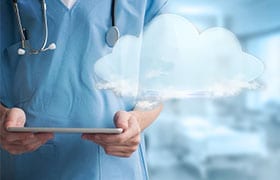3 min read
How Machine Learning and Wearables will take Healthcare to the next level
Anurag : Apr 6, 2017 10:00:00 PM
Machine learning impacts our lives almost every day but a lot of people are still confused about what exactly is machine learning and why the hoopla around it. To put it in simple terms, “machine learning is a practice of data analysis that mechanizes analytical model building. A learning machine which regularly keeps learning to keep its actions right and insights fresh is a true machine learning system. The data is fed into the learning machine with every action and non-action feeds and then the task gets automated without constantly requiring human or manual interference.”
The concept of machine learning emerged way back in 1945 when a US scientist anticipated a world of machines. It was just fiction then, but it's all turning to a reality now. We are well aware of the machine learning applications that are plying in our lives today. Some examples that we already are familiar with are online recommendation offers like those from Netflix and Amazon and even fraud detection algorithms in banks. Others include the self-driving Google car, and combining machine learning with linguistic rule creation to know what customers are saying about you on Twitter. There's also Nanotronics, that automates optical microscopes for improved inspections. There are even companies like Rethink Robotics which use it to create robots that can help manufacturers improve their production speeds.
Saving lives through Machine Learning
In most of the healthcare organizations now, machine learning along with other technologies is being implemented to deliver more suitable patient care at an affordable cost. Data is collected from a lot of sources like lab data, clinical data, actuarial data, physiological data and consumer data and is then integrated into one onto which machine learning techniques are applied. Geneia is one such technology which determines the missing values after matching them, looks at the data-cluster patterns and performs principal component analysis for the ongoing trends.
Add wearables and portable medical devices to the picture and the amount of information you get access to - along with direct access to the patient at any time - can lead life-saving situations. Big data along with machine learning is driving a business worth millions when it comes to the healthcare industry. It can be used to predict diseases or a medical condition before the emergence of symptoms, optimize treatment and find new cures for deadly diseases.

Human-augmented machine learning and wearables can wipe out preventable hospitalization which we call ‘remote patient intelligence.’ A wearable medical device can quickly catch any changes in the patient’s body. A fine example of this is, consider a person has been through congestive heart failure and is convalescing at home. Now the device would know if his weight, respiration rate or pulse oxygen level changed and the linked app would alert someone if his health might be deteriorating.
Another area where machine learning is helping is epilepsy care. Epilepsy is considered as one of the most unpredictable and serious neurological disorder. To check this disease, a group of doctors and neurologists worked on engineering a solution for the same. They came up with myCareCentric Epilepsy which combines a mobile app, Microsoft Band wristband, machine learning, shared care records and data analysis tools. The app works by collaborating all the patient information into a single record, kept in their database. The information is either fed by the patients themselves or the Microsoft Band wristband does it by sensing their sleep patterns, measuring movement, temperature, exercise, heart rate and galvanic skin responses. This data gets to the medical staff to notify them about the patient’s health and if he needs to be admitted to the hospital, epilepsy specialists can be arranged well in time.
Machine learning and IoT are also being used to treat speech disorders. A wearable accelerometer device is made to capture the motion of people’s vocal folds. The data obtained is then studied and related therapy is provided to the patients. This is gaining more importance because of the first-of-its-kind treatment. Usually, it's hard to tell the voice disorders by just listening for 20-30 mins but this device helps to catch the problem with extended results.
We know that number of healthcare providers for our aging population are too less, hence new, unconventional ways need to be looked in order to balance it. We should now be convinced that machine learning and wearables have a lot of potential in the near future. A human doctor cannot look at someone to tell if their heartbeats were irregular or what their potassium level was, but the machines can help in this regard. We would soon see machine learning and deep learning systems beside doctors during their practice.
Contact us to find out how you can implement machine learning to integrate data and use it with wearable devices.
 Read More
Read More
 Read More
Read More


